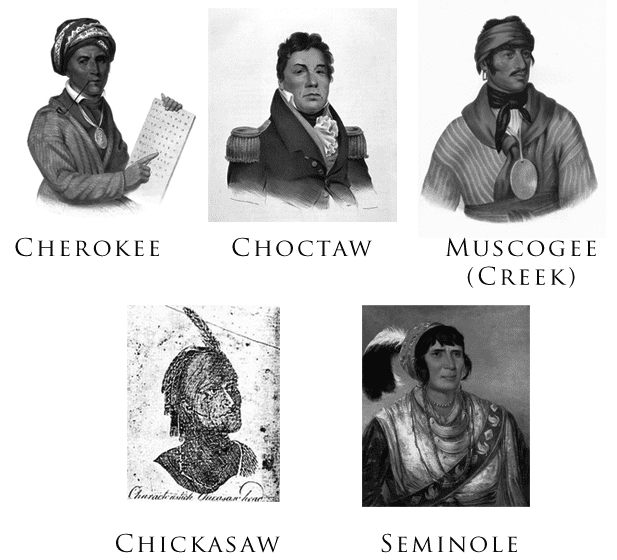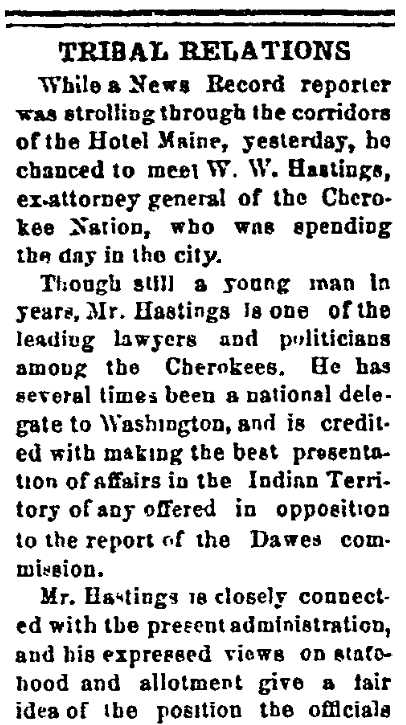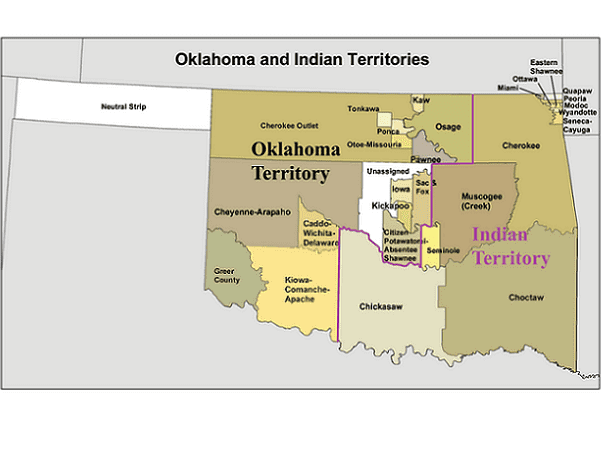Introduction: In this article – to help celebrate National Native American Heritage Month – Gena Philibert-Ortega explains how to use the Dawes Rolls for your Native American genealogy. Gena is a genealogist and author of the book “From the Family Kitchen.”
“My grandmother was a Cherokee Indian!” Many researchers start their genealogy journey because they’ve heard a family story of Native American roots. In many cases this might just simply be a family legend – but in others, the paper trail may confirm that story. For those with Cherokee, Creek, Choctaw, Chickasaw, and Seminole ancestry (known as the “Five Civilized Tribes”), one resource to use is the Dawes Rolls.

The Dawes Commission
What are the Dawes Rolls? President Grover Cleveland in 1893 appointed The Commission to the Five Civilized Tribes, also known as the Dawes Commission after its chairman Henry L. Dawes. This commission was to negotiate land with the Cherokee, Creek, Choctaw, Chickasaw, and Seminole tribes. The purpose of the commission’s work was to abolish tribal, communally-owned lands, and break these large areas into individual allotments for each member of the tribe – with the “surplus” land sold off to white settlers.

In order to receive land allotments, individual members of each tribe had to be deemed eligible for tribal membership. The Commission started the enrollment process in 1896 but that effort was deemed invalid, and they began again in 1898 which meant that anyone who had applied in 1896 had to re-apply. The Commission took applications until 1907; however, there were some additional individuals added up to 1914. (1)
What Are the Dawes Rolls?
The more than 101,000 names found on these “Final Rolls” are of those people eligible for tribal membership in the Cherokee, Creek, Choctaw, Chickasaw, or Seminole tribes. Information included in these records are: name, blood degree, and genealogical descent, and you may find supporting documentation including correspondence and vital records. The records available include enrollment cards, applications for enrollment, and letter logs. (2) Those who were eligible for tribal membership were entitled to land. The Rolls span the years 1898-1914.
What you will not find in the Dawes Rolls are “those applications that were stricken, rejected or judged as doubtful,” but it does include those who were not approved. (3,4) This is important because not everyone who was part of those five tribes is found on these Rolls for various reasons. Over 250,000 people applied but only 101,000 were approved. (5)
Also, if your ancestor was a member of one of the five tribes but did not live in Oklahoma Territory, they are unlikely to be found on the Rolls since there was a residency requirement. If you’re not sure where your ancestor was during the enrollment, you can search the 1900 U.S. Federal Census or the 1900 U.S. Indian Census Rolls to determine if your ancestor was living in the Oklahoma Territory during this time.
One last point. If your great-grandmother was Cherokee but deceased by the time of the enrollment, check for the names of her descendants who were living in Oklahoma Territory and may have enrolled.
For More Information
- To learn more about searching the Dawes Rolls and where they can be found online, see the FamilySearch Research Wiki article Dawes Commission Enrollment Records.
- The National Archives holdings include the Dawes Rolls, and their website has an article with information about the Rolls and how to search them.
- A free index to the Rolls can be found at the Oklahoma Historical Society website.
- Another free index to the Rolls is at the Access Genealogy website.
- GenealogyBank has a Native American newspaper collection that also might be of interest to you. The collection includes the Cherokee Advocate.
Be aware that if your purpose for your genealogical research is to prove your Native American ancestry, you will need to consult the tribe’s website for information about what is required for possible membership. More may be required than simply finding an ancestor listed on the Dawes Rolls.
_______________
(1) “Dawes Rolls,” National Archives (https://www.archives.gov/research/native-americans/dawes/tutorial/intro.html: accessed 21 November 2019).
(2) “Dawes Commission Enrollment Records,” FamilySearch Research Wiki (https://www.familysearch.org/wiki/en/Dawes_Commission_Enrollment_Records: accessed 21 November 2019).
(3) “Dawes Rolls,” National Archives (https://www.archives.gov/research/native-americans/dawes/tutorial/intro.html: accessed 21 November 2019).
(4) “Dawes Commission Enrollment Records,” FamilySearch Research Wiki (https://www.familysearch.org/wiki/en/Dawes_Commission_Enrollment_Records: accessed 21 November 2019).
(5) Ibid.
Related Articles:
- Native American Genealogy: Research Tips & Resources
- Three Steps to Beginning Your Native American Genealogy Research
- Cherokee Phoenix, the First Native American Newspaper
